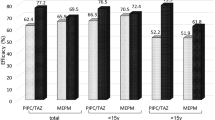Summary
In a prospective study 50 febrile episodes in severely neutropenic patients (neutrophils <500/mm3) were empirically treated with ceftazidime monotherapy. If no response was seen after 48 h, vancomycin was added. After another 72 h period, patients with persisting fever additionally received amphotericin B. In 29 episodes (58%) patients became afebrile with ceftazidime monotherapy. Another seven patients (14%) responded to the addition of vancomycin and five patients (10%) needed amphotericin B to become afebrile. A success of the study drugs without modification was seen in 40 episodes (80%), success with modification in three episodes (6%) and failure in six episodes (12%). One patient died of myocardial infarction. No other death occurred during the two-week observation period after entering the study. Though there were two gram-negative isolates resistant to ceftazidime, these patients were successfully treated with modification. It is concluded that the response-adapted additive sequence of ceftazidime, vancomycin and amphotericin B is an effective approach towards febrile episodes in severely neutropenic patients.
Zusammenfassung
In einer prospektiven Studie wurden 50 Fieberepisoden bei neutropenischen Patienten (neutrophile Granulozyten <500/mm3) empirisch mit einer Ceftazidim-Monotherapie behandelt. Trat nach 48 Stunden kein Ansprechen ein, wurde die Behandlung mit Vancomycin erweitert. Nach weiteren 72 Stunden wurde bei Patienten, die nicht ansprachen, eine systemische Amphotericin B-Therapie eingeleitet. In 29 Fieberepisoden (58%) entfieberten die Patienten unter Ceftazidim-Monotherapie. Sieben Patienten entfieberten erst nach Zugabe von Vancomycin und fünf Patienten nach Amphotericin B-Gabe. Ein Behandlungserfolg mit den Studienantibiotika ohne weitere Modifikation wurde in 40 Episoden (80%) beobachtet. In drei Episoden zeigte eine Modifikation Erfolg. Therapieresistent waren sechs Episoden (12%). Ein Patient verstarb an einem Myokardinfarkt. Alle anderen Patienten überlebten die zweiwöchige Beobachtungszeit. In zwei Fällen wurden Ceftazidim-resistente gramnegative Keime isoliert. Diese Patienten sprachen auf eine Modifikation der Behandlung an. Die am klinischen Erfolg orientierte additive Sequenz Ceftazidim, Vancomycin und Amphotericin B ermöglicht eine effektive und sichere empirische Behandlung von neutropenischen Patienten mit Fieber.
Similar content being viewed by others
References
Van Laethem, Y., Lagast, H., Klastersky, J. Serum bactericidal activity of ceftazidime and cefoperazone alone or in combination with amikacin againstPseudomonas aeruginosa andKlebsiella pneumoniae. Antimicrob. Agents Chemother. 23 (1983) 435–439.
Pizzo, P. A., Hathorn, J. W., Hiemenz, J., Browne, M., Commers, J., Cotton, D., Gress, J., Longo, D., Marshall, D., McKnight, J., Rubin, M., Skelton, J., Thaler, M., Wesley, R. A randomized trial comparing ceftazidime alone with combination antibiotic therapy in cancer patients with fever and neutropenia. N. Engl. J. Med. 315 (1986) 552–558.
De Pauw, B. E., Kauw, F., Muytjens, H., Williams, K. J., Bothof, T. Randomized study of ceftazidime versus gentamicin plus cefotaxime for infections in severely granulocytopenic patients. J. Antimicrob. Chemother. 12 (Suppl. A) (1983) 93–99.
Fainstein, V., Bodey, G. P., Elting, L., Bolivar, R., Keating, M. J., McCredie, K. B., Valdiviesio, M. A randomized study of ceftazidime compared to ceftazidime and tobramycin for the treatment of infections in cancer patients. J. Antimicrob. Chemother. 12 (Suppl. A) (1983) 101–110.
Verhagen, C. S., De Pauw, B. E., De Witte, T., Janssen, J., Williams, K., DeMulder, P., Bothof, T. Randomized prospective study of ceftazidime versus ceftazidime plus cephalothin in empiric treatment of febrile episodes in severely neutropenic patients. Antimicrob. Agents Chemother. 31 (1987) 191–196.
Klastersky, J., Glauser, M. P., Schimpff, S. C., Zinner, S. H., Yaha, H. Prospective randomized comparison of three antibiotic regimes for empirical therapy of suspected bacteremic infection in febrile granulocytopenic patients. Antimicrob. Agents Chemother. 29 (1986) 263–270.
Granowetter, L., Wells, H., Lange, B. J. Ceftazidime with or without vancomycin vs. cephalothin, carbenicillin and gentamicin as the initial therapy of the febrile neutropenic pediatric cancer patient. Pediatr. Infect. Dis. J. 7 (3) (1988) 165–170.
Rubin, M., Hathorn, J. W., Pizzo, P. A. Controversies in the management of febrile neutropenic cancer patients. Cancer Invest. 6(2) (1988) 167–184.
Verhagen, C., De Pauw, B. E., Williams, K. J., Du Bois, W. Ceftazidime sodium carbonate versus ceftazidime arginine as empirical monotherapy in febrile neutropenic patients. Eur. J. Clin. Microbiol. Infect. Dis. 2 (1988) 178–182.
Pizzo, P. A., Ladisch, S. L., Gill, F. Increasing incidence of grampositive sepsis in cancer patients. Med. Pediatr. Oncol. 5 (1978) 241–244.
Wade, J. C., Schimpff, S. C., Newman, K. A., Wiernik, P. H. Staphylococcus epidermidis: increasing cause of infection in patients with granulocytopenia. Ann. Intern. Med. 97 (1982) 503–508.
Winston, D. J., Dudnick, D. V., Chapin, M., Ho, W. G., Gale, R. P., Martin, W. J. Coagulase-negative staphylococcal bacteremia in patients receiving immunosuppressive therapy. Arch. Intern. Med. 143 (1983) 32–36.
Rubin, M., Hathorn, J. W., Gress, J., Steinberg, S. M., Pizzo, P. A. Gram-positive infections and the use of vancomycin in 550 episodes of fever and neutropenia. Ann. Intern. Med. 108 (1988) 30–35.
Donnelly, J. P., Marcus, R. E., Goldman, J. M., Cohen, J., Worsley, A. M., Catovsky, D., Darell, J. H., Want, S. V., Galton, D. Ceftazidime as first line therapy for fever in acute leukaemia. J. Infec. 11 (1985) 205–215.
Pizzo, P. A., Robichaud, K. J., Gill, F. A., Witebsky, F. G. Empiric antibiotic and antifungal therapy for cancer patients with prolonged fever and granulocytopenia. Am. J. Med. 72 (1983) 101–110.
Bauer, A., Kirby, W., Sherris, T. Antibiotic susceptibility testing by standardized single disc method. Am. J. Clin. Pathol. 45 (1966) 493–496.
Author information
Authors and Affiliations
Rights and permissions
About this article
Cite this article
Koeppler, H., Pflueger, K.H., Seitz, R. et al. Three-step empiric treatment for severely neutropenic patients with fever: Ceftazidime — Vancomycin — Amphotericin B. Infection 17, 142–145 (1989). https://doi.org/10.1007/BF01644013
Received:
Accepted:
Issue Date:
DOI: https://doi.org/10.1007/BF01644013




